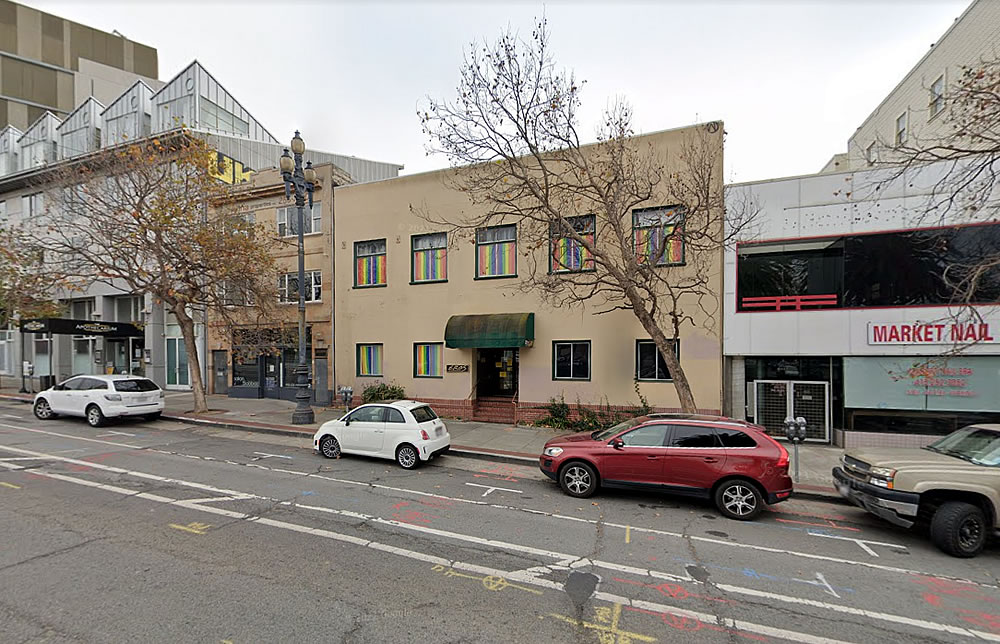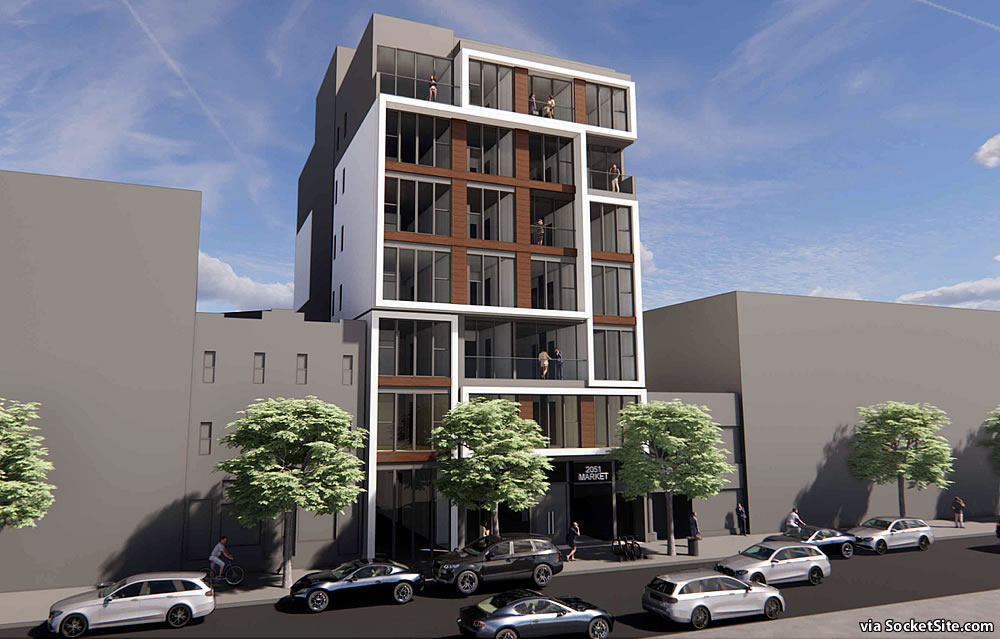A formal request to secure a demolition permit to raze the shuttered Eros bathhouse building at 2051 Market Street has been submitted to planning along with the paperwork to secure a building permit for a proposed 7-story residential development rise on the site, assuming the development is approved, the plans and Planning’s feedback for which for which we revealed last year.
While originally designed to yield 29 units, Winder Gibson’s revised plans for the site, which was acquired for $3.6 million three years ago, would now yield 24 units, a mix of 6 one-bedrooms, 12 twos and 6 threes, with an 1,800-square-foot retail space on the building’s ground floor, a 1,500-square-foot roof top deck for the building’s residents, and no garage.
We’ll keep you posted and plugged-in.


Hope the development group got their construction financing lined up three years ago. Because if they have to secure financing once the demolition and building permits are actually paid for and issued, they will find out if they don’t know it already that rates have ticked up substantially, and they’ll be competing for the attention of vulture investors and bottom-feeders looking to buy an entitled project for rock-bottom prices with all of the other real estate “geniuses”.
/s
Do you think that, even if the finacing was secured years ago, they’ll be paying other than (current) market rates ?? The only way I can see that not being the case is if they have a fixed rate loan that already started years ago; of course that would mean they’ve been paying for years for nothing…so hardly a good thing.
As for the bathouse site itself: Oh! if only those
wallsfloors could talk!!That was a sarcastic comment, but let’s proceed as if it was sincere. Assume that it’s true — like sparky-b said earlier this year — that it takes about five years for most S.F. projects to get all the required permits even when the project sponsor files all their paperwork in a diligent manner and pays all fees in a timely fashion.
In this post late 90s, financialized America, we should expect the all-singing, all-dancing credit market to respond with loan terms that are responsive to those practical constraints. I propose to address this with negative amortization level payments required during the the time it takes to get to the ground-breaking stage, with a balloon payment due when the site is ready for construction and the project is refinanced into a “normal” construction loan. We could call this a BUilding Permit Katalyst and Issuance Support, or BUPKIS, loan.
Such a loan program tailored to meet the needs of San Francisco’s flipper and developer community would allow a borrower with a project like this one to proceed from the “site permit approved by Planning” stage by taking out a loan to finance their carrying costs and the costs of intermediate work (structural drawings, architectural details, mechanical, plumbing, electrical, etc.) with minimal payments until after they reached approval for building permits (including demolition permits, if necessary) with interest rate protection with only one qualification, one appraisal, and only one set of fees/costs during the entire 60 month duration.
If a lender brought such a loan product into existence, they could hedge their risk that something might happen like The Fed raising the fed-funds rate by 525 basis points during the loan duration period by buying the appropriate derivatives in the futures market or with forwards or swaps.
The borrower could proceed with a development project not having to worry about getting their project approved and then being surprised years after they began the entitlement process when prevailing market rates make a project that’s just been approved “not pencil” and having to abandon the parcel if they can’t sell the partially-entitled property (they’d be paying for that privilege). They also wouldn’t have to be concerned with sudden tightened credit standards for construction loans due to idiosyncratic risk in the banking sector making their project nonviable for unforeseeable reasons.
The business case almost writes itself. If you happen work for a non-bank lender, you don’t have to pay me a fee for that multi-million dollar loan product idea or cut me in as an equity partner, I’m giving it to you for free.
I’m giving it to you for free
Well, now, that I recognize as sarcasm.
I assume this will get entitled but not built, since nothing is penciling out right now. Then it will get shopped and maybe, if they’re lucky, sold. Then it will probably still not get built – perhaps we’ll be in the throes of the “builder’s remedy” by then and the city will have lost all planning and zoning authority, so it’ll be redesigned again, maybe with several additional stories. I’m not too optimistic about shovels in the ground until interest rates, and maybe construction costs too, decline significantly..
If you are waiting for a “builder’s remedy” to be available here like in certain other more suburban California counties, you’re going to be waiting for quite a while. I am not a land use attorney, but just going on what I have heard on the news, San Francisco’s update to its Housing Element was approved and accepted by The State earlier this year, so no “builder’s remedy” is going to be available to any of the developers or other hangers-on in the real estate “game” who have largely arrived here from elsewhere with dollar signs in their eyes, and no loss of local authority over planning or zoning will take place in the foreseeable future.
Ah, that’s what they want you to think.
There is a periodic reporting of actual housing production required, and cities are required to actually issue *building permits* (not just entitlements) for a pro-rata share of the required housing production at each of those reporting periods, or those cities will lose their ability to entitle projects and the state will take over. When that happens, there are NO zoning controls and projects only have to meet the building code requirements. I think the first reporting period happens in 2027 but I might be wrong. But since there is a near-zero chance that SF will have issued building permits for 30,000+ units by then, we can anticipate the “builders remedy” to kick in when we miss our production target. This has not been well publicized but I believe it to be true.
Eros was a sex club, not a bathhouse. There were no bathhouses in San Francisco in the years Eros was operating.
So you’re familiar with the establishment then? :-))
Very. What would you like to know?
😉
What’s the big deal? This isn’t high school.
I’m not in the target demographic, but I did live through the yuppification of Capitol Hill in Seattle. The terms “bathhouse” and “gay sex club” were used almost interchangeably in articles about the redevelopment of neighborhood institutions like Club Z and Steamworks.
If you were in the demographic, you would understand that they are two very different things. And, in San Francisco, bathhouses were illegal for the entire time Eros was in business at this location.
You are absolutely right. There hasn’t been a bathhouse in San Francisco since the 80’s.
This is one of those “if you know, you know” things. The difference between the two is quite significant for those of us who have patronized these businesses.
Okay, now do the Safeway across the street.